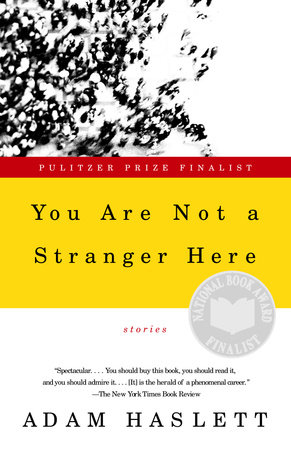You Are Not a Stranger Here Reader’s Guide
By Adam Haslett


1. In what ways are the nine stories in You Are Not a Stranger Here unified? What kinds of characters, situations, and thematic concerns recur throughout the book?
2. Why does Adam Haslett begin the collection with a story told from the point of view of someone suffering from mental illness? How does this story affect the reader’s perceptions of the stories that follow it? What does “Notes to My Biographer” reveal about being in a manic state?
3. In “The Good Doctor,” Frank experiences “a familiar comfort being in the presence of another person’s unknowable pain. More than any landscape, this place felt like home” [p. 41]. Why would Frank feel this way? Does such a feeling make him a more empathetic therapist, or does it indicate a kind of narcissistic relationship to his patients? In what ways are readers of You Are Not a Stranger Here in a position similar to Frank’s?
4. At the end of “The Beginnings of Grief,” why does the narrator cry, “for the first time in a long while,” when his shop teacher, Mr. Raffello, delivers the “dark amber chest” [p. 64], he has made? Why would seeing this particular object make him weep? What might his crying signify?
5. In “Devotion,” Owen observes that reading Othello in school did not help him to deal with his own jealousy. “What paltry aid literature turned out to be when the feelings were yours and not others’” [p. 78]. Should literature be an aid to understanding and controlling one’s own feelings? In what ways might You Are Not a Stranger Here make readers more fully aware of their own and others’ emotional states?
6. Why does Hillary, at the end of “Devotion,” feel herself “there again in the woods, covering her brother’s eyes as she gazed up into the giant oak” [p. 88]? In what ways does the story reenact this earlier moment of protection?
7. In “Reunion,” as James enters the final stages of AIDS, he writes a series of letters to his dead father. “I find you now and again here on the common, bits and pieces of you scattered in the woods, but as the days go by, so the need lessens. I’ll be coming home soon”[p. 131]. In what sense does he “find” his father on the common?
8. In “Divination,” after Samuel voices his premonitions, his father tells him: “You’re twelve years old and you have a lot of ideas in your head, but nothing will wreck you quicker than if you let yourself confuse what’s real and what isn’t…. I don’t know what it is you’re dreaming, or what you dreamt about that teacher, but that’s all it is—dreams. Your life’s got nothing to do with those shadows, nothing at all” [p. 157]. In what ways does “Divination,” and indeed the entire book, question the distinction between what’s real and what isn’t? In what ways do the “dreams” and “shadows” referred to above have everything to do with the characters’ lives in You Are Not a Stranger Here?
9. In “My Father’s Business,” the narrator’s father wants to inoculate himself against the present: “So much easier if you can see people as though they were characters from a book. You can still spend time with them. But you have nothing to do with their fate” [p. 185]. How might such an attitude have affected the narrator’s own fate? How does this statement relate to the narrator’s desire to “figure out the relationship between the desire for theoretical knowledge and certain kinds of despair” [p. 177]?
10. When Paul asks Mrs. McLaggen in “War’s End” if she often invites strangers into her home, she replies: “You’re not a stranger here” [p. 106]. Why might Adam Haslett have chosen this line as the title for the collection?
11. In “Volunteer,” Ted at first resists the idea of visiting the Plymouth Brewster Structured Living Facility: “Enough already with the fucking mentally ill, for Christ’s sakes, enough, but something made him come” [p. 213]. What is it that draws him there? What role does his own family life play in his decision to volunteer there? What kind of relationship does he establish with Elizabeth? What do he and Elizabeth give each other?
12. What do the stories of You Are Not a Stranger Here, taken as a whole, say about mental illness, about madness and love, and about the relationships between parents and children? In what ways do these stories give us a new look at the age-old subject of family life?
Just for joining you’ll get personalized recommendations on your dashboard daily and features only for members.
Find Out More Join Now Sign In